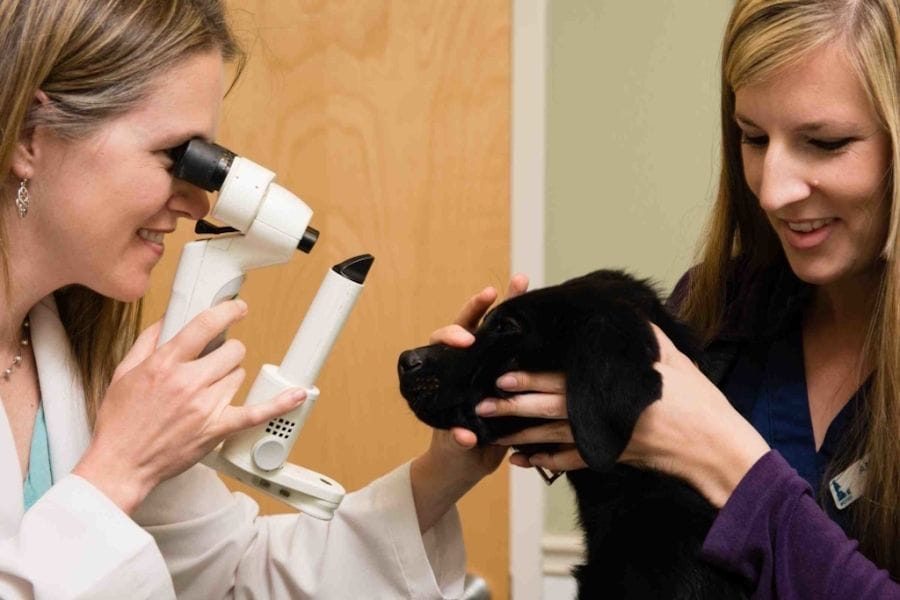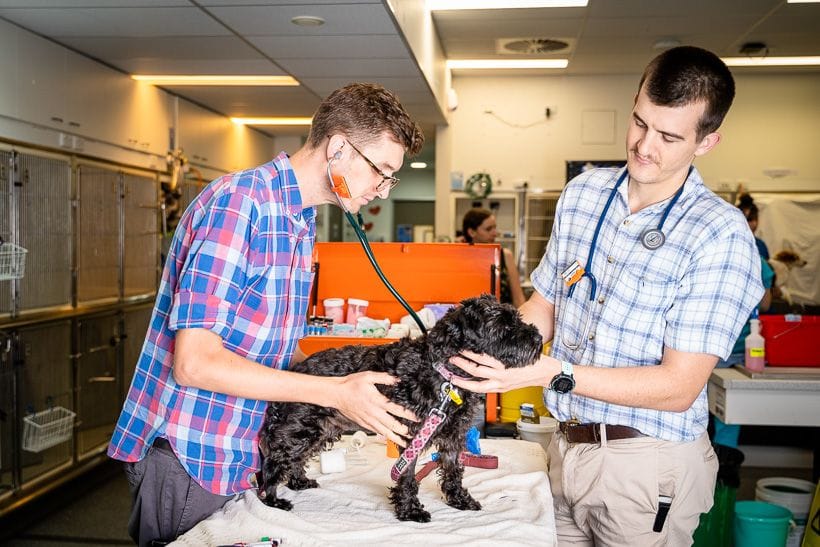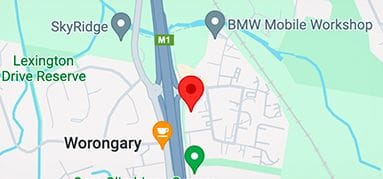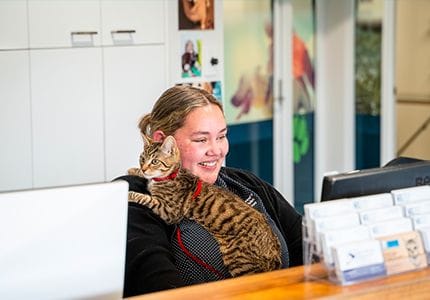We also believe in owners having maximal information about their brachycephalic pet subsequent to a visit with us. This allows owners to make ongoing decisions that they feel are in the best interest of their pet. Information is a powerful tool. Some owners of brachycephalic pets may believe that some, or all, of the clinical symptoms their pet are displaying are normal for the breed, when indeed the pet is suffering from exercise intolerance, sore eyes or regurgitation. These misconceptions are never intentional. Often owners, once they are fully informed, want to know what the options are to improve their pet’s quality of life.
Brachycephalic Care Unit (BCU)
Specialised Brachycephalic Care in Brisbane & Gold Coast
We also believe in owners having maximal information about their brachycephalic pet subsequent to a visit with us. This allows owners to make ongoing decisions that they feel are in the best interest of their pet. Information is a powerful tool. Some owners of brachycephalic pets may believe that some, or all, of the clinical symptoms their pet are displaying are normal for the breed, when indeed the pet is suffering from exercise intolerance, sore eyes or regurgitation. These misconceptions are never intentional. Often owners, once they are fully informed, want to know what the options are to improve their pet’s quality of life.

Finally, in everything BCU does, it aims to improve the quality of life of the Brachycephalic pet and reduce complications associated with surgery or hospitalisation. This is an area VSS have been involved in researching, for the past 20 years.
The following information outlines the common conditions we see these patients for, and importantly, how BCU will aim to capture other health conditions at the time of visit.

Common Conditions in Brachycephalic Dogs

Surgery Department

Ophthalmology Department

Internal Medicine Department
Surgery
Surgery
Spinal Disorders
A neurological examination will tell us how severely affected a patient is, and we will also be able to localise the problem to a region(s) of the spinal cord.
Grade 2 neurological injury is where a patient has neurological deficits such as paresis (weakness), decreased proprioception and changes in ability to ambulate (walk).
Grade 3 is where the paresis is severe enough that the patient is non-ambulatory (unable to walk) and has significant neurological deficits.
Grade 4 is where additionally the patient is paralysed in the affected limbs. This describes where they have no ability to consciously move the limbs, which we call absence of motor function. A grade 4 patient however, has pain sensation. This is a test where we apply a painful stimulus to the toes and watch to see whether the patient reacts. It is important to note, that withdrawal of the limb is not the same as a reaction, as this can occur as part of a reflex.
Grade 5 patient is where this pain sensation is lost. They have a complete paralysis and can’t feel anything. We call this ‘Deep Pain Negative’. This is the most severe injury, and these patients should be operated on within 12-24 hours. Brachycephalic breeds may be prone to other spinal abnormalities, such as hemivertebrae, where the vertebrae develop abnormally. These can be asymptomatic or can contribute to spinal instability or disc degeneration.
The BCU is committed to treating spinal conditions in brachycephalic dogs, and all dogs treated for a spinal condition will receive an airway examination and report.
Orthopaedic Disorders
All dogs that are anaesthetised to investigate an orthopaedic disorder will receive an airway exam and report. In reverse, patients anaesthetised for their airway surgery, will have a CT scan that examines the joints.
Humeral condylar fractures are a fracture configuration we commonly see in French Bulldogs. These are complex fractures to repair and are important for us to see as soon as possible. This is because the fracture involves the joint surface, and delay in repair can result in difficulty reducing the fracture perfectly due to callus (early healing) formation. When we are repairing fractures that involve the joint, careful attention is paid to anatomical alignment and rigid fixation. Unfortunately, with these fractures, some degree of osteoarthritis is common.
Brachycephalic Obstructive Airway Syndrome (BOAS)
Brachycephalic Obstructive Airway Syndrome is a term that describes the primary and secondary airway abnormalities that lead to a disrupted normal airflow. The symptoms of this can be related to the airway obstructive disease or gastrointestinal disease (which is often exacerbated by airway disease). There is a wide range of clinical signs that our surgeons see associated with this disease, however the main ones include gagging while eating, regurgitation of food, snoring, intolerance to normal amounts of exercise or heat, and sleep apnoea. Affected dogs may not have all of these symptoms.
We address as many issues as possible, without increasing patient morbidity/risk of complication. An individualised approach is taken, after a careful examination of the airway. Possible surgical interventions include; staphylectomy (shortening of the soft palate), tonsillectomy (resection of everted tonsils), sacculectomy (resection of laryngeal saccules, when everted), alaplasty (to widen the nares) and less commonly; other palatoplasty procedures (to modify the thickness or shape of the palate), arytenoid lateralisation (to permanently open the larynx), laser assisted turbinectomy and tracheostomy (temporary or permanent bypass of air via the trachea).
One of the key things we want owners of brachycephalic dogs to be aware of is that brachycephalic airway syndrome is progressive - it only gets worse. We really want to intervene surgically in these patients as early as possible to prevent chronic and in some cases, irreversible airway pathology.
We Aim to Capture Other Health Conditions in Patients Referred for Airway Surgery
- We perform a full-body Computed Tomography (CT). This is a very quick procedure (<60 seconds) and gives us additional information. Specifically, we look at the patient’s spine, oesophagus, middle ear, chest, nasal turbinates, and especially for French Bulldogs, we look at their elbows for signs of humeral intercondylar fissure.
- Skull CT also allows us to look at dentition. Brachycephalic patients have an increased risk of some dental conditions. See the information below for common dental conditions. Each patient anaesthetised for airway surgery with us will receive a dental examination and report under the guidance of Advanced Animal Dentistry.
- Each patient anaesthetised with us for airway surgery will receive an Ophthalmic report. See the information below for common ophthalmic conditions. The perfect stress-free time to perform an eye exam on a brachycephalic patient is whilst under anaesthesia.
- Active follow-up for resolution of both airway signs but also gastrointestinal signs following surgery. Our goal is to ensure our brachycephalic patients are not lost to follow-up.
Ophthalmology
Ophthalmology Department
Brachycephalic Dogs Often Have Under-recognised Uncomfortable Ophthalmic Disease
- Abnormally prominent eyes, that are insufficiently protected by their eyelids (lagophthalmos).
- increased incidence of hairs contacting the cornea from nasal fold trichiasis (normal hairs orientated towards the eye), medial canthal entropion (lids rolling in), and hairy caruncles (hair growing from conjunctiva at the medial canthus).
- Persistently overexposed cornea from macroblepharon (oversized opening between the upper and lower eyelids).
- increased risk of traumatic proptosis (eyeball prolapse out of the eye socket getting trapped in front of the eyelids).
- distichiasis and ectopic cilia (extra lashes implanted in the wrong location and causing direct trauma to the cornea).
- reduced corneal innervation and sensitivity which reduces blinking, tear production and impedes corneal healing.
- prolapsed gland (cherry eye)and folded cartilage of the third eyelids.
Our BCU team will report on any ophthalmic disorders at the same time as airway surgery. Additionally, patients anaesthetised for elective (not emergency) treatment of an eye condition, will receive an airway examination and report.
Internal Medicine
Internal Medicine
With respect to gastrointestinal disease, symptoms can be exacerbated by brachycephalic airway syndrome. Generally, patients receive medical management until their airways can be addressed and then we closely monitor for ongoing gastro-intestinal symptoms. If these symptoms are ongoing, further investigation is indicated.
Medical Investigation for Gastrointestinal Disease
- Fluoroscopic swallow study. This is where we observe a bolus of food enter the mouth and watch its transit to the stomach.
- Abdominal ultrasound
- Gastrointestinal endoscopy and biopsy
- Bloodwork, urine analysis
Diagnostic investigations sometimes require a general anaesthetic. If this is the case, we endeavour to have a surgeon perform an airway assessment. This is not always possible if the patient presents in an emergency situation requiring an anaesthetic as soon as possible. Mostly however a surgeon is available to coordinate with, to examine the airway at the time of anaesthesia and issue an airway report.
Advanced Animal Dentistry
Brachycephalic Dogs Are Prone to Dental Issues
Impacted or unerupted teeth. The concern here is that impacted teeth if not extract can form dentigerous cysts within the jaw. These cysts are expansile and if not treated can result in extensive damage to the surrounding teeth and bone. Extraction of impacted teeth prior to cyst formation is a far less invasive and extensive procedure. Impacted teeth can be identified when combining the results of a CT examination with an oral examination, and this is one of the many reasons we CT our brachycephalic patients prior to airway surgery.
Overcrowding
Malocclusion
Anaesthesia
BCU Benefits
Airway Assessment and Surgery Patients Receive:
- An Ophthalmic Report
- A Dentistry Report
Elective Eye Surgery Patients Receive:
- An Airway Report
- A Dentistry Report
Orthopaedic/Spinal Procedures Patients Receive:
- An Airway Report
&geometry(278x56))






